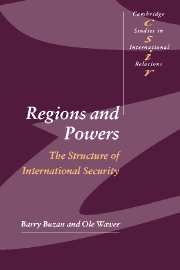Book contents
- Frontmatter
- Contents
- List of illustrations
- Preface
- List of abbreviations
- 1 Patterns of regional security during the Cold War
- 2 Patterns of regional security post-Cold War
- Part I Introduction: developing a regional approach to global security
- Introduction
- 1 Theories and histories about the structure of contemporary international security
- 2 Levels: distinguishing the regional from the global
- 3 Security complexes: a theory of regional security
- Conclusions
- Part II Asia
- Part III The Middle East and Africa
- Part IV The Americas
- Part V The Europes
- Part VI Conclusions
- Glossary
- References
- News media
- Index of names
- General Index
- CAMBRIDGE STUDIES IN INTERNATIONAL RELATIONS
Introduction
Published online by Cambridge University Press: 05 December 2009
- Frontmatter
- Contents
- List of illustrations
- Preface
- List of abbreviations
- 1 Patterns of regional security during the Cold War
- 2 Patterns of regional security post-Cold War
- Part I Introduction: developing a regional approach to global security
- Introduction
- 1 Theories and histories about the structure of contemporary international security
- 2 Levels: distinguishing the regional from the global
- 3 Security complexes: a theory of regional security
- Conclusions
- Part II Asia
- Part III The Middle East and Africa
- Part IV The Americas
- Part V The Europes
- Part VI Conclusions
- Glossary
- References
- News media
- Index of names
- General Index
- CAMBRIDGE STUDIES IN INTERNATIONAL RELATIONS
Summary
Almost nobody disputes that the end of the Cold War had a profound impact on the whole pattern of international security but, more than a decade after the transition, the character of the post-Cold War security order still remains hotly contested. This book explores the idea that, since decolonisation, the regional level of security has become both more autonomous and more prominent in international politics, and that the ending of the Cold War accelerated this process (Katzenstein 2000). This idea follows naturally from the ending of bipolarity. Without superpower rivalry intruding obsessively into all regions, local powers have more room for manoeuvre. For a decade after the ending of the Cold War, both the remaining superpower and the other great powers (China, EU, Japan, Russia) had less incentive, and displayed less will, to intervene in security affairs outside their own regions. The terrorist attack on the United States in 2001 may well trigger some reassertion of great power interventionism, but this is likely to be for quite narrow and specific purposes, and seems unlikely to recreate the general willingness to intervene abroad that was a feature of Cold War superpower rivalry. The relative autonomy of regional security constitutes a pattern of international security relations radically different from the rigid structure of superpower bipolarity that defined the Cold War. In our view, this pattern is not captured adequately by either ‘unipolar’ or ‘multipolar’ designations of the international system structure.
- Type
- Chapter
- Information
- Regions and PowersThe Structure of International Security, pp. 3 - 5Publisher: Cambridge University PressPrint publication year: 2003

